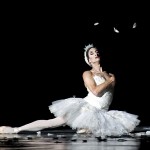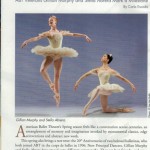As the many glories of American Ballet Theatre’s Met season unfold, the press finds itself alternately in states of rapture and disdain. Audiences held their breath as the magnificent Diana Vishneva, Marcelo Gomes, Natalia Osipova, and Jared Matthews made a wreckage of their love lives in ‘Onegin’. Meanwhile The New York Times asked ABT Artistic Director Kevin McKenzie whether the company’s decisions to fly in foreign guest stars was hurting morale among ABT’s home-grown dancers. McKenzie was frank in admitting his own repeated disappointments as a principal dancer when previous artistic directors Lucia Chase and Mikhail Baryshnikov chose to cast guest stars over him. Now he is in the unenviable position of having to balance his dancers’ needs and egos against audience demand for celebrities – a particularly challenging task in this era when every arts company is facing depressed ticket sales.
Across the Atlantic, legendary ballerina Lynn Seymour ripped into the Royal Ballet for “failing to address the needs of the creative individual” and for “indiscriminate casting of too many alternative principals.”
State-run Russian companies operate in a different economic and political environment and have never felt the need to import foreign stars – that is, until last year, when the Bolshoi brought in David Hallberg from ABT, which drove at least one Bolshoi principal into a jealous fury.
Joan Acocella in this week's New Yorker sums up the prevailing ambivalence toward guest stars: “however incorrect the policy, it would take a lot to persuade me that [ABT] should not have brought in Alina Cojocaru for the past few Met seasons.”
Cojocaru is a model of the modern ballerina-without-borders: trained mainly in Kiev, she is arguably the brightest star at the Royal (now that Tamara Rojo has decamped to run English National Ballet), and she guests frequently enough with ABT to be considered part of the American company as well.
Whether this is healthy for the home team or not, artistic directors who do not have access to stable, long-term sources of funding are forced to put a target number of “bums in seats” every season… and if it takes a famous guest star to do this, they’ll fly her in.






Dynamite piece from Lynn Seymour!
‘Regional’ US Companies seem to have been doing this with respect to importing National Stars, and Semi/Non-Professional Companies seem to have been doing with with respect to importing Regional Stars, so….. it makes sense to me for this to happen at the next level up…
Which way this will go if we ever discover or are discovered by an alien humanoid species.. wow, who could say who will have the interstellar stars (ha ha) the humans or the humanoids ?
Ballet San Jose flew in Carlos Acosta from the Royal Ballet… all it takes is a donor with deep pockets.
I do agree that this is a good practice, in small doses – helps to attract audiences, and provide a diversity of inspiration for dancers on the home team. Tough balancing act for the artistic directors, however. There are always going to be resident dancers who feel slighted.
It’s all about money, and big stars fill seats. I think it’s the same reason the classic ballets are performed again and again season after season. Swan Lake, Romeo and Juliet and Don Quixote are household names and sell seats. Cojocaru and Vishneva sell seats. Buns in seats – end of story.
{quote by “Adria Rolnik”}… Buns in seats – end of story.{/quote}
Buns in seats for the Buns on heads.. I like it.